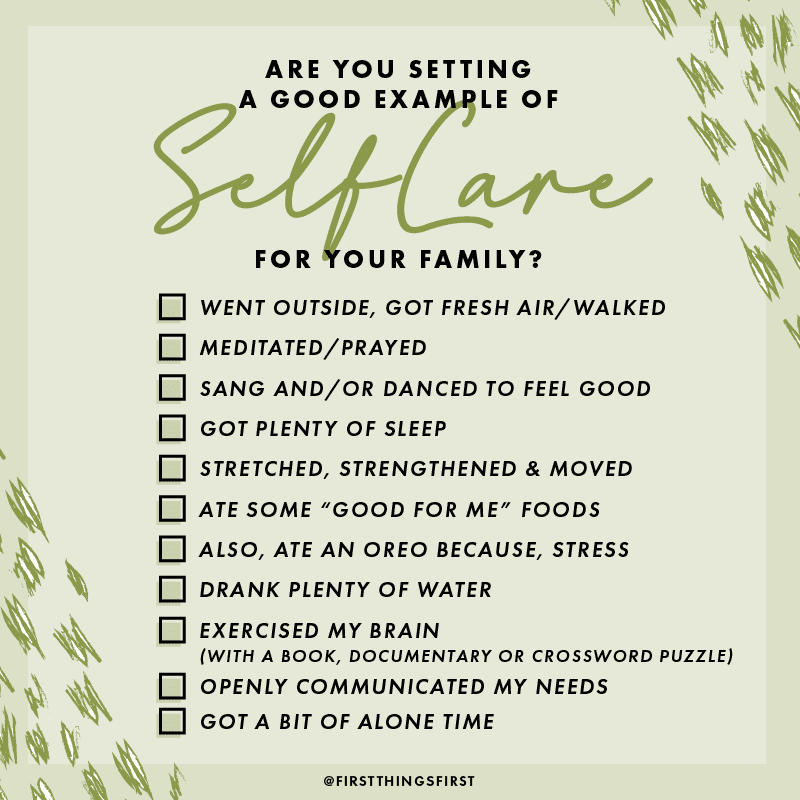
Create a Family Self-Care Plan
When you’re a parent, self-care often slips to the bottom of the list. But taking care of yourself isn’t a luxury. It’s essential. And during the pandemic when stress is running especially high, it’s more important than ever.
Self-care is for everyone. Simply put, self-care is the practice of taking actions to improve health… both physically and emotionally. Kids and adults need time to refresh, recharge and unwind from work, school, and current events. While it’s important to focus on self-care individually, it is also important to prioritize as a family to support healthy communication and a better understanding for how to support our loved ones.

Your family can benefit from a self-care plan if:
- you want your family to get into the habit of self-care
- you’re worried about time and money when it comes to self-care
- you’re not managing to stick to a self-care routine
Why should self-care be a priority for families?
Practicing self-care can make you feel happier and more physically, mentally and emotionally able to deal with life’s pressures and stresses. This is especially true for busy families during the hectic holiday season! For parents and caregivers like yourself, ensuring self-care is a priority makes sense, as it helps parents be better caregivers. It also role models positive behavior for teens, which they’ll adopt and benefit from into adulthood.
What self-care works for you?
Self-care is different for everyone – you might have to work together to figure out the best options for each of you. Ask everyone to think about these questions individually:

- What activities make you feel good and recharged?
- What would you like to do more of?
- Are there any activities that you look forward to during the week?
- What would your ideal day look like? What activities would you do?
If you’re struggling to think of specific activities, think about:
- For parents (who may have forgotten!): What did you love doing before you had kids?
- For children: Remind them of the things you’ve seen them enjoying.
Think low budget or free. This is about filling hearts with joy, not emptying your bank account. Take this quiz to find out what sort of self-care works for you. For some more examples, check out this great list of holiday-themed self-care ideas:

Take Action!
A few simple steps and a family brainstorm is all it takes to make self-care a priority at home. Get creative and modify as needed over time.
1. Create space for planning. Set time aside on a weekend or after dinner one night during the week to come together as a family and begin planning. It’s important to make sure that everyone can be present so the plan is representative of the family, as self-care can be practiced in many ways.
2. Set goals or clarify purpose. Creating a self-care plan can be simply to integrate mindfulness and other forms of relaxation into busy family schedules, or it can have attached goals. Think about things your family may want to work on together (e.g. decreasing screen time by an hour each day, reducing stress associated with busy schedules, etc.). Identify top stressors and use as a template to build out a plan that helps you achieve goals to decrease and improve on how you manage them.
3. Brainstorm activities. Create a nice balance of 5 or 6 activities. Activities included in a self-care plan should be inclusive of activities that support the mind and body.
- Caring for the body. Exercise, proper hydration and good nutrition directly influence our social and emotional health. Find ways to incorporate some activities into your current routine rather than adding to.
- Create a water tracker to support hydration and encourage healthy swaps to sugary drinks. Idea: Test out new water infusions with fruits and herbs.
- Nourish your body with healthy foods – cook healthy meals together during the week. Idea: Have each family member pick a new recipe and try out new foods together.
- Exercise and incorporate physical activity. Idea: Take a family walk or bike ride after dinner or sign up for a virtual exercise class or lesson together.
- Caring for the mind. Supporting our emotional health can look a little different for everyone. Include activities that feel the most natural to you or challenge yourself with something new.
- Engage in meaningful connection. Idea: Create regular space to talk together about feelings (e.g. Sunday morning coffee chat)
- Practice mindfulness. Idea: Journal, paint or doodle feelings, thoughts and emotions or practice deep breathing or yoga.
- Nourish the mind with meaningful activities. Idea: Limit screen time and social media by setting a daily time to put away devices or swap for mind strengthening games.
- Caring for the heart. Sharing in the activities we love most is great for building and maintaining strong relationships as it creates space to learn from others while enjoying activities that bring us joy.
- Get some fresh air. Idea: Eat dinner outside with a backyard picnic or play outside together.
- Learn something new together. Idea: Start a family book club or do a family show and tell.
- Play together. Idea: Play board games or have a movie night and create space for downtime as a family.
4. Determine frequency. Once you have a list of activities, work together to prioritize the ones that make the most sense for your current schedule and determine a frequency. Example: Maybe your family wants to start taking family walks after dinner and create space for a family check-in. You might keep family walks to twice a week in the beginning and use time already in place (e.g. eating breakfast together on Saturday mornings) to do a family check-in.
5. Keep it where you can see it. Post your family self-care plan in a place where you can see it often. This can help serve as a reminder of your commitment and help you to keep it prioritized.
This family self-care plan is a great example of what yours might look like:


